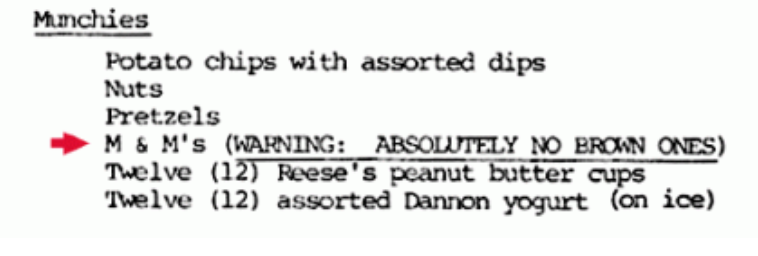Van Halen’s secret to avoiding disaster
I first heard the story on This American Life, but it seemed apocryphal.
When the band Van Halen was touring, the story goes, they required a bowl of M&M’s as snacks — with the brown ones removed.
For years, if the band’s requirement wasn’t discounted as a rumor, it was viewed as an absurd rock star excess. The band’s capriciousness demanded the removal of brown M&M’s from the bowl of candy, along with snacks like herring cream cheese and essentials (Tupelo honey and KY Jelly, for example).
Well, it turns out that it’s true! And there’s a really good reason for it.
Here’s David Lee Roth, the band’s lead vocalist, from his autobiography (as quoted on Snopes.com):
We’d pull up with nine eighteen-wheeler trucks, full of gear, where the standard was three trucks, max. And there were many, many technical errors — whether it was the girders couldn’t support the weight, or the flooring would sink in, or the doors weren’t big enough to move the gear through.
… there was so much equipment, and so many human beings to make [a show] function. So just as a little test, in the technical aspect of the rider, it would say “Article 148: There will be fifteen amperage voltage sockets at twenty-foot spaces, evenly, providing nineteen amperes …” This kind of thing. And article number 126, in the middle of nowhere, was: “There will be no brown M&M’s in the backstage area, upon pain of forfeiture of the show, with full compensation.”
So, when I would walk backstage, if I saw a brown M&M in that bowl … well, line-check the entire production. Guaranteed you’re going to arrive at a technical error. They didn’t read the contract. Guaranteed you’d run into a problem. Sometimes it would threaten to just destroy the whole show. Something like, literally, life-threatening.
It’s brilliant.
One of the things that we write about in Meltdown (read a free sample here) is the idea that it’s hard to observe what’s actually going on in many complex systems. Whether that’s because of the hidden features of abstract things (like correlations between complex financial products) or the difficulty of observing physical systems (you can’t send someone into the core of a nuclear power plant or to the bottom of the ocean to see a wellhead).
But transparency is often the antidote to complexity: even when we can’t simplify our systems, we can make things more visible. For example, banks that used a unified system to quantify their exposures (compared with those that emailed spreadsheets around) had a better understanding of their risk in the lead-up to the 2008 financial crisis.
That’s akin to what Van Halen did with the brown M&M’s: find something that could help them understand the hidden risks they were facing.
It’s what I do with my consulting clients: we seek clear indicators for how our work is going and how we’re changing a team’s behaviors. I do it with my coaching clients: we create indicators that reveal the hidden beliefs that motivate actions, particularly the beliefs that work against someone’s stated goal.
What about you? How do you try and inject transparency into your systems?

